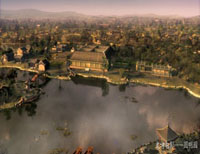
Plans to build a 20 billion yuan (US$2.5 billion) replica of Beijing's Yuanmingyuan, known overseas as the Old Summer Palace, in east China have met fierce opposition from academics.
Hengdian Social and Economic Federation, who operates a complex featuring imitations of the Forbidden City and a Qin Dynasty palace often used for film sets, has announced it will build a replica of the former imperial summer park, looted and burnt down in 1860 by Anglo-French Forces, over a 347-hectare area in five years.
The plan is fervently opposed by cultural heritage specialists like Professor Ruan Yisan, director of the State Institute of Famous Historical and Cultural Cities with the Shanghai-based Tongji University.
"The Yuanmingyuan took 150 years to build. It can not be recreated in five or ten years," Ruan insisted. "The replica is unnecessary because the Yuanmingyuan was destroyed by the Allied Forces and the present-day ruins serves as a testimony to that period of humiliating history.
"It would be of greater value to spend the money on ancient cultural heritage sites which are in dire need of protection or build some modern mansions blended with the cream of ancient Chinese architecture.
"If the replica is billed as a tourist attraction, it might lose a lot of money, given the huge funds needed for its construction," he said.
China has 2,500 such tourist sites, with an investment of 150 billion yuan (18.75 billion U.S. dollars). Only ten percent of them are profitable.
Ruan is not alone in his opposition. Ye Yanfang, a researcher with the institute of foreign literature with the Chinese Academy of Social Sciences, said the destruction of the Yuanmingyuan was like a scar left by the powerful western nations on the back of the Chinese nation. Preserving the ruins in Beijing would protect the true facts of history.
But Xu Wenrong, chairman of the Hengdian federation behind the plan, will not be swayed. He believes the Yuanmingyuan ruins can continue to serve as a reminder of history, while the replica in Hengdian can display the artistic achievements achieved by the Chinese before 1860.
"Nothing can change my mind. This project is a long-held ambition of mine and I have been collecting materials from the original Yuanmingyuan, which were scattered all round the country and overseas, for 15 years," said 72-year-old Xu.
The funds required for the project will be raised by personal donations and corporate investment. A special entity, Zhejiang Hengdian Foundation for Chinese Cultural Development, was set up last May to be responsible for collecting public funds.
Some of Xu's supporters believe the Yuanmingyuan replica is a symbol of China's prosperity, a stark contrast to the Yuanmingyuan ruins. They say that it will give the younger generations an opportunity to express patriotism.
According to historical records, construction of the original Yuanmingyuan began in 1707 and continued for 150 years under five emperors of the Qing Dynasty (1644-1911). It consisted of three interconnected gardens covering an area of 350 hectares, of which 140 hectares was water.
The yuanmingyuan is now listed as a site for "patriotic education".
Hengdian Social and Economic Federation led by Xu Wenrong has won fame for a development featuring imitations of the Forbidden City in Beijing, a palace of Qin Dynasty (221-206BC), and a prosperous Song Dynasty (960-1279) downtown street.
The development attracted 3.3 million visitors last year.
(Xinhua News Agency September 27, 2006)
|

